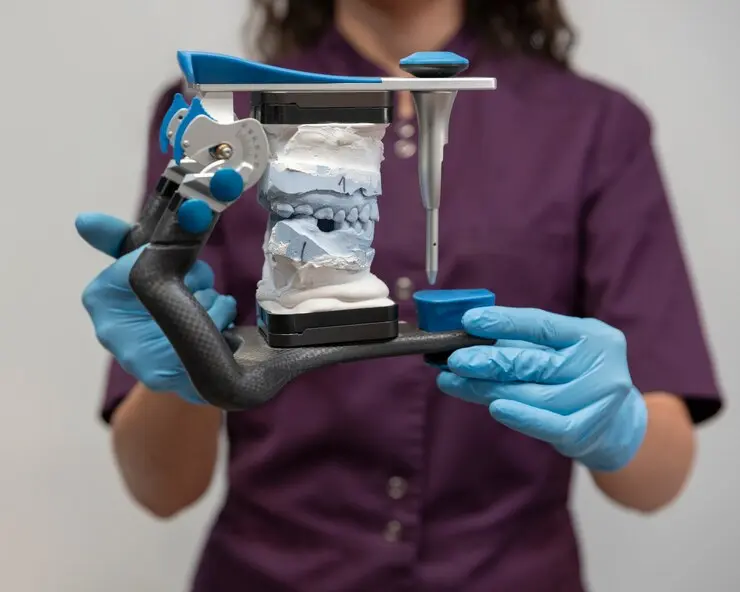Losing teeth can happen to anyone, and it’s not just about the gap in your smile. It can affect your health and daily life. But there’s good news! There are ways to fix it, like traditional dental implants and All-on-4 implants. Let’s break it down so you can choose what’s best for you and get your dental implant providers on it.
What Are Traditional Dental Implants
Traditional dental implants are like artificial tooth roots. They’re made of small, screw-shaped posts that your dentist puts into your jawbone. These dental implants near me don’t just replace the visible part of the tooth; they also take the place of the roots, which makes them a sturdy, long-term solution for missing or damaged teeth.
The Dental Implant Procedure
Getting traditional implants isn’t a one-time thing. It involves multiple visits to your dentist. First, they’ll surgically place the implant into your jawbone. Then, you have to wait for a few months for a process called osseointegration to happen. This is when the implant fuses with your jawbone, creating a solid foundation. Once that’s done, your dentist attaches a custom-made tooth to the implant, matching it perfectly to your natural teeth.
What Are All-on-4 Implants
All-on-4 implants are like a full set of replacement teeth, but they’re held in place by just four implants. They’re a great option if you’re missing several teeth or if your teeth are in really bad shape. Unlike removable dentures, All-on-4 implants are permanent and feel more like your own teeth.
The All-on-4 Procedure
What’s cool about All-on-4 implants is that you can get them all in one day! The dentist places the implants and the new teeth on the same day. There’s no need to wait for things to heal like with traditional implants. Plus, the way they’re angled under your gums gives them extra stability.
Traditional Implants vs. All-on-4 Implants
Both traditional dental implants and All-on-4 implants are used to replace missing or damaged teeth, but they work differently.
Traditional implants take longer because they require multiple visits to the best dentist in San Jose and a waiting period for the bone to fuse. All-on-4 implants, on the other hand, are quicker – you can get everything done in a single day!
When it comes to cost, All-on-4 implants can be more affordable, especially if you need to replace several teeth.
Benefits of All-on-4 Implants
-
One Surgery: Everything gets done in a single appointment, saving you time and hassle.
-
Less Need for Bone Grafting: With All-on-4, you usually don’t need extra bone added to your jaw, which speeds up the process.
-
Cost-Effective: If you’re replacing many teeth, All-on-4 could be cheaper than traditional implants.
-
Better Oral Health: All-on-4 implants help prevent further decay and gum disease.
-
Restores Normal Function: You can eat and talk without worrying about your teeth slipping or moving.
-
Improved Appearance: Say goodbye to gaps and hello to a confident smile!
-
Ideal for Multiple Tooth Replacements: Perfect if you’re missing several or all your teeth.
Foods to Eat Immediately After Getting Dental Implants
After your dental implant procedure, it’s essential to take care of what you eat to aid in your recovery process. Here’s a guide to the foods you should consume during the initial hours and days post-surgery:
-
Liquids Only for the First Hour: After the surgery, you’ll need to wait at least an hour before having your first snack. This allows the gauze sponges placed in your mouth to remain undisturbed for proper healing.
-
Stick to Cool Liquids: For the first 48 hours, opt for liquids like smooth cold soups, broths, applesauce, meal replacement drinks, smoothies, protein drinks, and juices. Avoid hot foods or beverages as they can irritate the surgical site.
-
Avoid Using Straws: Drinking through straws or water bottles creates suction, which can dislodge blood clots and interfere with healing. Stick to sipping from a cup or glass.
-
Hydrate with Water: Drink plenty of water to stay hydrated, aiding in your recovery process. Avoid alcoholic beverages and smoking, as they can hinder healing.
Foods to Eat in the Weeks After Dental Implant Surgery
Once the initial 48 hours have passed, you can gradually introduce soft foods into your diet. Here are some suggestions for the weeks following surgery:
-
Soft Grains: Cooked cereal grains like oatmeal or cream of wheat are easy to eat and provide essential nutrients.
-
Soft Cooked Potatoes: Mashed, baked, boiled, or fried potatoes (or sweet potatoes) offer variety and are gentle on your healing gums.
-
Eggs: Scrambled, poached, or in an omelet form, eggs are soft, protein-rich, and packed with vitamin D, aiding in the healing process.
-
Dairy Products: Milk, yogurt, and soft cheeses provide valuable calcium for strong teeth and are easy to consume.
-
Leafy Greens: Cooked leafy greens such as kale and spinach offer essential nutrients and are gentle on your healing gums.
-
Tender Meats: Opt for tender and soft-cooked meats like fish (salmon, cod, halibut) for protein without risking discomfort.
Conclusion: Your Smile, Your Choice
Deciding between traditional implants and All-on-4 comes down to what works bestTraditional Implants vs. All-on-4 Implants for you. Talk to your dental implant providers to figure out which option suits your needs. Whether it’s a long-term process with traditional implants or a quick fix with All-on-4, the goal is the same – a health.

